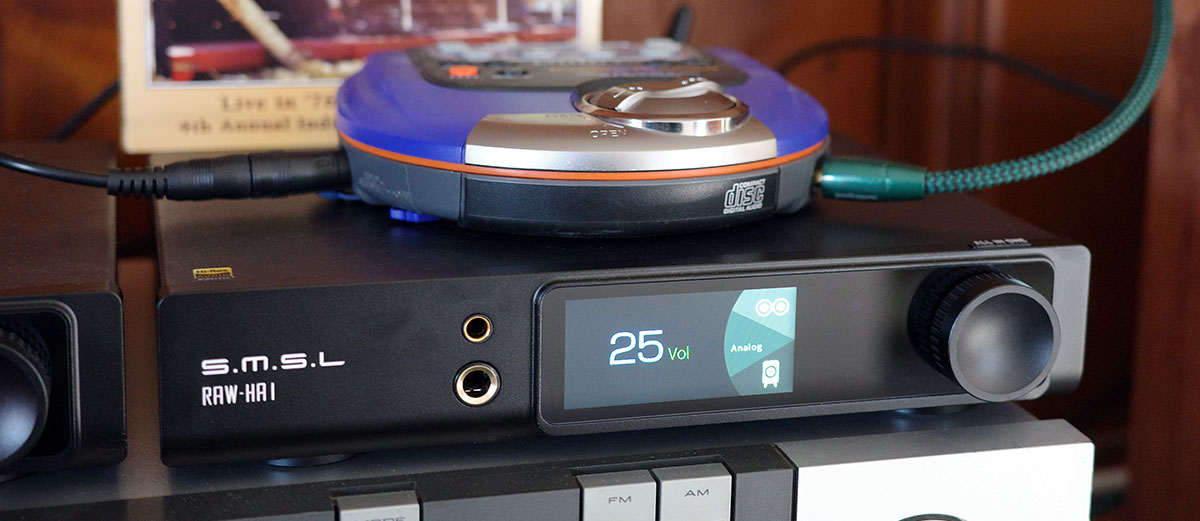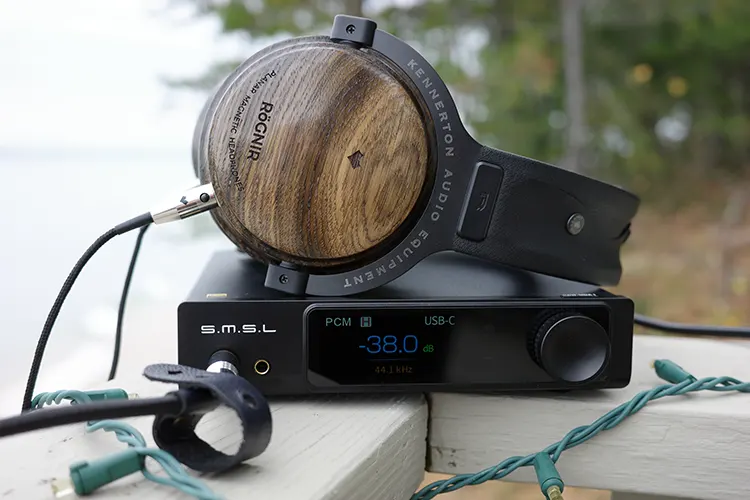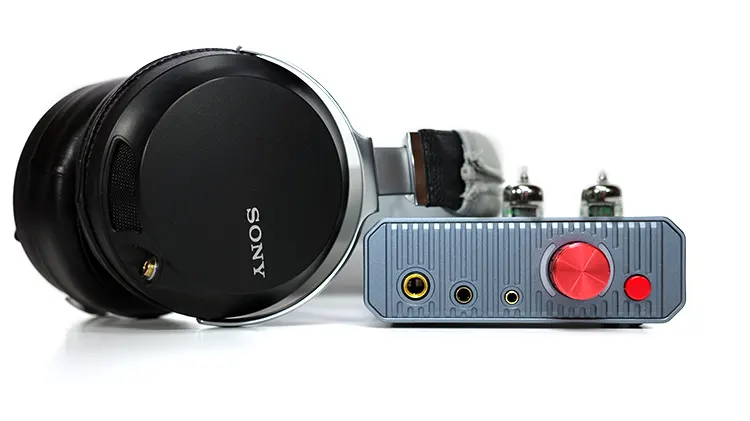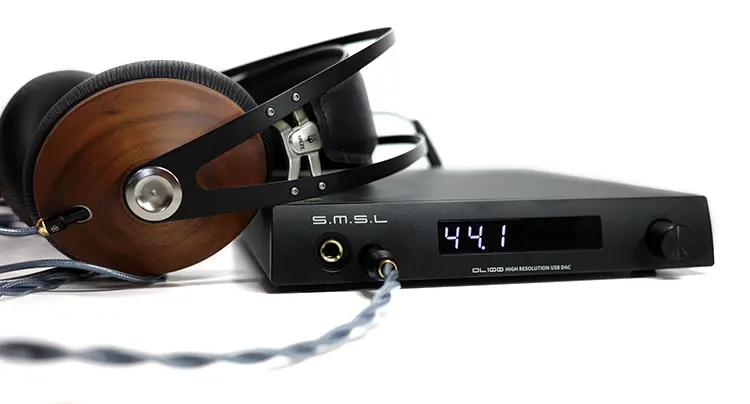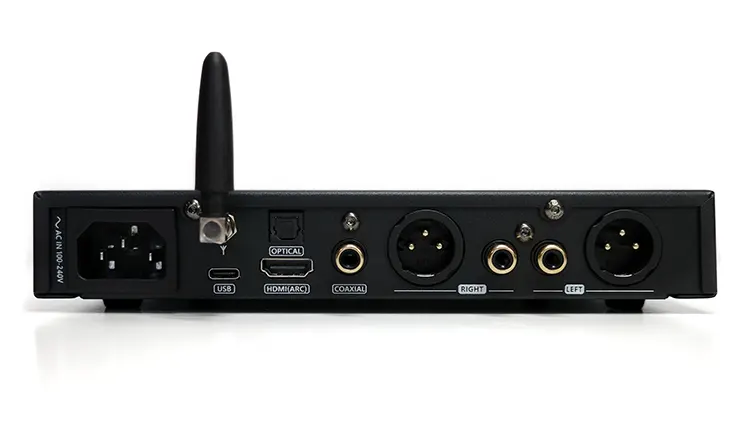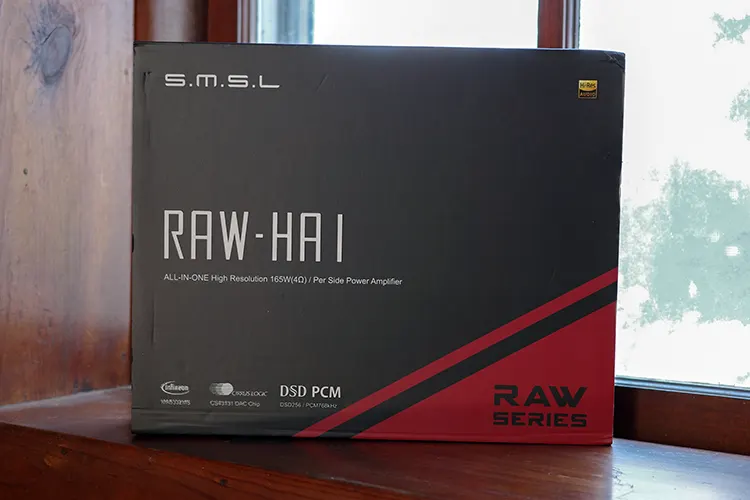Select Comparisons
SMSL RAW-MDA1
Features
The RAW-MDA1 uses ESS DAC chips and TI’s OPA 1612A Opamps (set up in dual mode), while the RAW-HA1 uses Cirrus Logic chips and Infineon’s power amplification chip. The RAW-HA1 provides much more power, but that is expected from two-channel listening.
The third generation XMOS XU-316 is capable of DSD256, PCM up to 32bit/768kHz is the same on both, and DoP64 with up to 5 PCM digital filters is had on the MDA1.
The mentioned PCM filters carry a slightly different weight on the RAW-HA1 but follow the same route.
Included on the MDA1 is something called “sound color,” which changes the sound signature from various levels of richness, tube sound, or crystal sound options (3 of each), besides the “standard.”
This would be similar to equalization on the RAW-HA1, providing a different route for sound customization.
The RAW-MDA1s headphone amplifier can deliver up to 1.57W at 32Ω and 2.5W at 16Ω making it adequately powerful on its own, far surpassing the RAW-HA1. Both isolate the power from other circuitry ensuring clean operation.
The Qualcomm QCC5125 BT 5.1 module supports up to aptX HD and LDAC decoding giving you all of the common wireless codecs at your fingertips. This is the same module on the RAW-HA1.
Design
The RAW-MDA1 carries a small footprint, just like the brethren SMSL DL100 mentioned below. The versatility for placement this provides is much appreciated. While not that much smaller than the RAW-HA1, the difference might be felt in smaller spaces.
The matte black finish on all sides (which I am beginning to appreciate more and more) makes for an unassuming piece of gear, meaning it can go about its business without drawing too much attention to itself.
With its 189 x 45 x 179mm (W x H x D) diminutive size (7.4 × 1.8 × 7in) and weighing in at a little over a kilo at 1.02kg (2.24lbs), comparing favorably to the RAW-HA1s larger dimensions and heft, which is 50% heavier.
Performance
The sound emanating from the RAW-MDA1 varied by source input naturally, and the music source being used. I preferred the balanced output for listening over the 6.35mm single-ended, much like I do on the RAW-HA1.
The balanced option helped to spread the soundstage out, allowing the instruments to exercise in their own space. Plus, the balanced output gives a cleaner signature, to me.
Where the RAW-HA1 focused more on height, the MDA1 carried a more equal dimensionality to the presentation.
The RAW-MDA1 promotes a nearly neutral signature, displaying warmth and richness only if the source or music played does so (or when one of the cool filters is chosen).
This comes across as one of the more neutral DAC/amps as opposed to the thinner upper midrange and treble of the RAW-HA1, which counters a lower bottom end.
The lows are more polite than the RAW-HA1 and without bloat or bleed into the mids. The top-end reach will add a bit of sparkle and a distinct clarity to the notes without becoming grating or harsh.
The RAW-HA1 carries more weight down low but shares a similar response in the upper reaches of source music, albeit a bit thinner.
xDuoo MH02
Features
The xDuoo MH02 is a Class A buffered transistor headphone amplifier that uses 6J1 tubes as the pre-amplifier, warming what might be a colder, more sterile sound. The GE5654W tubes I installed warm the sound even more. This comparison used those GE tubes.
Capable of decoding up to PCM 32bit/384kHz, MQA 32bit/384kHz, & DSD256 through the USB input, the characteristics fall right in line with this level of amplifier, but behind the higher ratings of the RAW-HA1.
Keeping the Pre-amp and amplifier separate also helps contain potential noise interference, especially where tubes are concerned. The MH02 isolates each minimizing interference and potential noise pitfalls.
This also helps isolate any of the typical tube “ping” you might hear when touching the surfaces of the MH02 when it is operating.
With up to 1300mW (32Ω), the MH02 drives most higher-impedance headphones. A single CS43131 DAC chip (as opposed to a single Cirrus Logic in the RAW-HA1) carries a low noise floor and high decoding abilities. Both do their jobs within the sphere of each amplifier.
Power is deceiving, since to me, the MH02 drives harder headphones easier than the RAW-MDA1, or at least to higher perceived volume levels.
The gain switch can add either 12dB or 18dB for headphones that need a higher output to perform.
Since the “normal” output most likely would be the 12dB gain, it should be considered a baseline, meaning a +6dB gain between each setting is more realistic. The RAW-HA1 carries the traditional L, M, and H gain settings.
Design
The MH02 carries a small rounded, rectangular footprint, roughly a little less than half the size of the RAW-HA1, with the two tubes sticking out of the top adding to the aura.
The sandblasted aluminum shell has “slots” to help dissipate heat giving the unit a more industrial look, especially with the gray coloring.
Carrying 120 X 78 X 40mm dimensions and a svelte weight of 0.35kg makes the unit imminently placeable within your system within reason.
The tube look will make you want to show it off, though, especially if you go tube rolling. The MH02 is quite small compared to the RAW-HA1, and it shows.
Performance
Tube amplifiers usually promote a smoother, warmer signature, and the MH02 follows this but with a level of detail somewhat on par with a Class-A amplifier of this class.
There is plenty of power to drive higher impedance headphones with ease mostly, and I rarely had to use the high gain setting. The same cannot be said regarding the RAW-HA1, which carries much less note weight using high-impedance headphones.
When using high gain though, the midrange is elevated and enhanced, pushing it to the forefront, but without losing clarity on both ends too much.
The RAW-HA1, on the other hand, stays close to the same signature, without acting like a loudness button, except for the SDB function in the equalizer setting.
The treble is smoothed by the tube coloration, with bass that digs a bit deeper, and without the familiar elongated, thumping notes typical of a tube amplifier.
The RAW-HA1’s extra reach is appreciated in lighter genre music, giving extra room for the notes to spread vertically, instead of the smoothing effect of the tubular MH02.
Limited by the stock tubes, the sound comes across as fairly typical of a tube amplifier in this range, but with a grainier personality.
Using the NOS GE5654W tubes I purchased specifically for the MH02, I enjoyed the added level of detail (and smoother character), which the stock tubes could not match.
Tube rolling is something you cannot do with the RAW-HA1, but neither can the MH02 run speakers; which in this case is a huge benefit.
The sound is not nearly as detailed and clear as the SMSL RAW-HA1, but the fun is when you change tubes, giving a different sound characteristic, as opposed to an equalizer or PCM filter changes.
SMSL DL100
Features
With 4 CS43131 chips, as opposed to one in the RAW-HA1, the DL100 was labeled as 2024’s first quad-chip, and TI’s OPA1612A Op-amps, as opposed to the Infineon amplifier chip, running the amplification. Both include an HDMI (ARC) cable connection.
Along with a dual USB connection (1.1 & 2.0 for easy game system connection), both can be incorporated into a potential system for HDMI ARC TV users and gamers.
The third generation XMOS XU-316 is capable of DSD Native 256, PCM up to 32bit/768kHz, and DoP64, which is the same as the RAW-HA1.
Five PCM filters allow for personalization ranging from NOS (no sampling), FL1 (Fast and Low-latency), FL2 (Fast and Phase-compensated), FL3 (Slow and Low-latency), to F4 (Slow and Phase-compensated).
The RAW-HA1 carries the same PCM filter choices but also includes the ability to adjust treble and bass along with seven equalizer settings for various effects.
The DL100 amplifier can deliver up to 1.5W at 32Ω and 3.0W at 16Ω making it quite powerful on its own, which is again more than the RAW-HA1. Power implementation is kept separate on both.
The Qualcomm QCC5125 BT 5.1 module supports LDAC, aptX, aptX HD, AAC, and SBD giving you all of the common wireless codecs exactly like the RAW-HA1.
Design
There is no getting around the diminutive size of the DL100, especially with how thin it is, height-wise. This can give the user many beneficial options for placing the unit within their system. It looks like a mini-RAW-HA1 from the front.
With its 196 x 31 x 206mm diminutive size (7.7×1.2×8.1in) and weighing in at a little over a kilo at 1.05kg (2.31 lbs.), which is again about 33% less than the RAW-HA1’s weight.
The slightly canted sides separate the look from the RAW-HA1, adding a bit of flair. I find this shape helps me grab hold of the DL100 when necessary and if anything, it has a slightly different look than a regular black rectangular HiFi box.
Performance
I preferred the balanced output for listening, much like the RAW-HA1 (except for the two-channel).
The balanced option helped to spread the soundstage out, allowing the instruments to exercise in their own space, as opposed to the higher qualities of the RAW-HA1. The RAW-HA1 seems to be SMSL’s exception regarding the soundstage going higher instead of wider.
The DL100 promotes a neutral signature, displaying warmth and richness only if the source or music played does so.
More neutral than the RAW-HA1s thinner qualities up top, but also less musical to me. I preferred the RAW-HA1 sound not only for the ability to tailor it but also because it comes across as more musical to me.
Its lows offer aplomb when called upon, but without bloating the sound, or carrying over into the mids, which I appreciated. The top-end reach will add a bit of sparkle and a distinct clarity to the notes, without becoming grating or harsh.
Again, seemingly typical SMSL, where the RAW-HA1 takes a different path with thinner, but more musical tonality up top, and better grunt down low.
My Verdict
When the SMSL RAW-HA1 arrived, I knew in advance that having the ability to hook up in two-channel mode would be a plus. What I didn’t quite realize was that would be the best aspect of the RAW-HA1.
Providing plenty of power for your bookshelf (or larger) speakers gives the user many options for use. When used through the HDMI input, you can make for a much-improved TV listening setup, at a pretty modest investment.
Using the speaker option in straight two-channel mode also gives you plenty of options for small to medium space.
It is only when we go into headphone mode that the limitations are heard. The RAW-HA1 does not have enough power to drive high-impedance headphones to adequate listening levels. This is a fault of many headphone amplifiers, but it is especially felt here.
The RAW-HA1’s headphone amplifier section performed quite well when used with IEMs, however, don’t expect it to drive harder-to-drive IEMs or headphones.
That shortcoming aside, the multitude of input options makes the RAW-HA1 a worthy option at this level, and the internal DAC is quite good for the level needed. Adding an external DAC would turn the RAW-HA1 into a very good performer.
I also enjoyed the BT feature, running the FiiO TT13 through the RAW-HA1 and bookshelf speakers for an excellent listening experience. That is how I ended this by listening to the RAW-HA1 in two-channel mode and came away satisfied with the performance.
SMSL RAW-HA1 Technical Specifications
- THD+N: 0.003%
- SNR: 108dB
- Channel Separation: 87dB
- Input Sensitivity / Input Impedance: 245mV / 22kΩ
- Output Power (Stereophonic): 4Ω: 165W x 2, 8Ω: 85W x 2
- USB Transmission: USB 2.0 (Asynchronous Transfer)
- USB Compatibility: Windows 7/8/8.1/10/11, Mac OSX, Linux
- MQA Decoder: USB, Optical, Coaxial
- MQA-CD Decoder: Optical, Coaxial
- Bit Depth: USB: 1bit, 16-32bit, Optical/Coaxial: 1bit, 16-24bit
- Sampling Rate: USB (PCM): 44.1–768kHz, USB (DSD): 2.8224–11.2896MHz, Optical/Coaxial, (PCM): 44.1–192kHz, Optical/Coaxial (DSD): DSD64 (DoP)
- Bluetooth Specification: 5.1 (supports SBC, AAC, aptX, aptX HD, LDAC)
- Power Consumption: 40W (Normal Volume)
- Size: 8.62 x 1.77 x 7.48 inches (219 x 45 x 190 mm)
- Weight: 3.42 lbs (1.55 kg)

